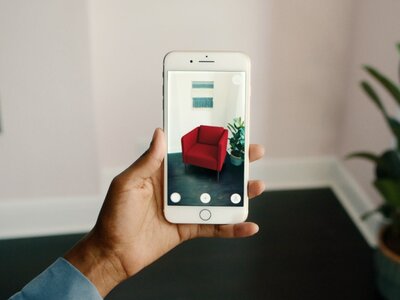VR vs. Mixed Reality vs. AR for eCommerce: The Right Fit for Your Shop

AR for eCommerce is changing online shopping, but it’s not alone. Today's technological advancements allow for immersive experiences unlike any others before.
Specifically, virtual reality (VR), augmented reality (AR), and mixed reality (MR) have changed the way people interact with both the virtual and physical worlds. While these technologies are often used in video games to immerse gamers, mixed reality, VR, and AR for eCommerce are also changing the way people shop.
If you want to harness the power of these technologies for your business, it's important to understand the differences between them and how they work. Here we'll review the similarities and differences between VR, AR, and mixed reality, along with how you can use each to enhance your eCommerce business.
What Is VR?
Of these innovative solutions, virtual reality (VR) is the one with which people are most familiar. Unlike AR and mixed reality, VR is entirely immersive. It uses headsets and virtual worlds to trick the user through their senses into believing they're in an environment that's entirely separate from the real world.
Through either headsets or head-mounted displays (HMDs), users can view computer-generated imagery and hear sounds from within that virtual space. In some applications, users may simply be able to explore the space. Alternatively, they may be able to manipulate virtual objects in others.
What Is AR for eCommerce?
.gif?width=600&name=kitchenaid%20AR%20(1).gif)
VR may transport users to another digital space, but augmented reality (AR) brings virtual elements into the real world. Unlike VR, AR can project 3D models and other digital information over real-world environments to combine the two worlds.
Popular video game apps such as Pokémon GO have used this technology to help immerse users, but it's also invaluable for retailers and other businesses.
AR for eCommerce uses smartphones, tablets, and other devices to enable users to view and interact with virtual objects and information. Users could view how a particular product might look in a designated space in their home, for example.
It serves as a type of "try before you buy" application.
What Is Mixed Reality?
Like AR, mixed reality — or MR — mixes the real world with the virtual. But it does so in a somewhat different way.
In a mixed reality environment, users can interact with both virtual and physical objects. This allows users to manipulate virtual objects using their hands and other tools as they would in real life.
Some devices used to interact with virtual objects in a physical space could include headsets or smart glasses. They blur the lines between reality and virtual reality.
Because mixed reality is the newest of these immersive technologies, it isn't as widely used as either VR or AR. However, that may change in the near future. Companies like Microsoft, Acer, and Lenovo are developing technology with MR in mind.
eCommerce Applications for VR, AR, and Mixed Reality
If you're wondering which technology is best to use to create a unique store experience when shopping online, there are different applications available for each one. Based on the types of products offered and whether a brick-and-mortar store comes into play, you may find uses for VR, AR for eCommerce, or mixed reality.
Transporting Customers With VR
Businesses are finding ways to use virtual reality to fully immerse potential customers by showing them virtual worlds and objects. VR is popular among businesses that want to give customers the ability to:
- Explore virtual showrooms
- Take tours of real estate
- Visit other spaces digitally when it may not be as easy to do so physically
Some companies may also use VR as part of their marketing campaigns. They can highlight certain services or products, showcasing their capabilities in an impressive virtual demonstration.
For example, in 2017, retailer IKEA launched multiple virtual reality popup stores in Jordan, Kuwait, and Morocco, with small corresponding physical stores in malls within those countries. Customers could visit these small 4-by-4-meter locations. Then they could use VR technology to shop for accessories and furniture across several floor plans. Customers could then purchase furniture either online or in-store.
VR vs. Mixed Reality vs. AR for eCommerce: What's the Right Fit for Your Store?

One of the best ways to improve the customer experience for many businesses today is through the use of AR solutions on eCommerce websites. AR for eCommerce has become particularly important over the course of the pandemic, as people were forced to spend more time online at home while yearning for the in-store shopping experience.
At the same time, people shopping online want to be certain of what they're getting. AR is also becoming increasingly popular among shoppers, with 71% of consumers stating that they would shop more frequently if they could use AR.
Through a real-time AR experience, prospective customers can see how products would look using AR apps on Apple iOS, Android, and other mobile devices right from home. Furniture is a particularly popular product to showcase via AR. Many furniture stores have AR features that allow customers to view virtual furniture in their living rooms and other spaces.
However, many other businesses can use AR technology to improve the online shopping experience. In addition to furniture, customers can even "try on" virtual jewelry, clothing, accessories, or even makeup without setting foot in a physical store.
This is especially useful for custom products. The customer may want to see these “in person” before committing to a particular custom look, design, or functionality. Other products that can benefit from AR solutions include building materials and modular construction, sports equipment, and much more.
If you would like to find out more about how to use AR for eCommerce applications, click here.
The Potential for Mixed Reality Experiences in the eCommerce Industry
As a relatively new technology, there aren't currently many use cases around mixed reality applications. But with innovations on the horizon, this could change. Companies are primarily finding it to be useful in:
- Prototyping products in virtual spaces
- Assisting with design modeling
- Engineering
For instance, Ford is using mixed reality to design its vehicles using the Microsoft HoloLens headset.
In the world of eCommerce, mixed reality could become more prevalent. It can act as a means of enabling consumers to get a sense of a product's look and feel before buying. VR can transport customers to the store, AR for eCommerce can let people view the product, and mixed reality would enable customers to physically manipulate different products, focusing more on the "feel" of the product.
By using smart glasses and other tech, consumers may even be able to browse a physical store while interacting with various virtual components and interfaces. This effectively combines the two worlds into one.
However, it may be a while before we see mixed reality become as integrated as VR and AR.
Use AR for eCommerce With Threekit's Solutions

VR, AR, and mixed reality can each enhance eCommerce sites in different innovative ways. But AR remains one of the best ways to increase customer confidence and, subsequently, conversion rates. If you're in the market for the ideal augmented reality experience to bring to your customers, consider trying Threekit's unique AR features.
With the help of our AR solution and other aspects of our platform, such as our Virtual Photographer software, you can bring your products to life through photorealistic 3D models. To learn more about our AR capabilities, reach out to us today.




